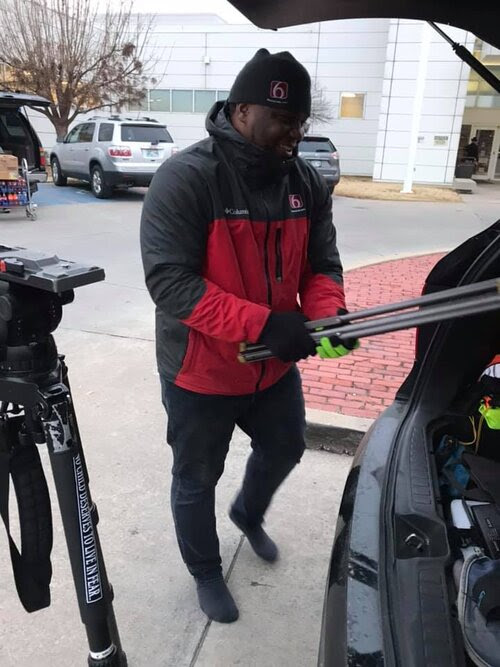Why High Error Rates Should Concern Newsrooms
Impeachment Covered Through Alternative Facts
Andrew Yang Sees Media Slight Over His Race
Blacks Trust Media More Than Latinos, Whites
Black Female Journalists Were Fierce in 1800s
NPR Renews Pledges on Diverse News Sources
Lincoln Michel Joins Indian Country Today
How to Survive Christmas as a Muslim
Photog Gives Freed Inmate the Shoes on His Feet
Short Takes

Why High Error Rates Should Concern Newsrooms
“Facial-recognition systems misidentified people of color more often than white people, a landmark federal study released Thursday shows, casting new doubts on a rapidly expanding investigative technique widely used by law enforcement across the United States,” Drew Harwell reported for the Washington Post. Use of the technique is also taking place in newsrooms.
“Asian and African American people were up to 100 times as likely to be misidentified than white men, depending on the particular algorithm and type of search,” the story continued. “Native Americans had the highest false-positive rate of all ethnicities, according to the study, which found that systems varied widely in their accuracy.
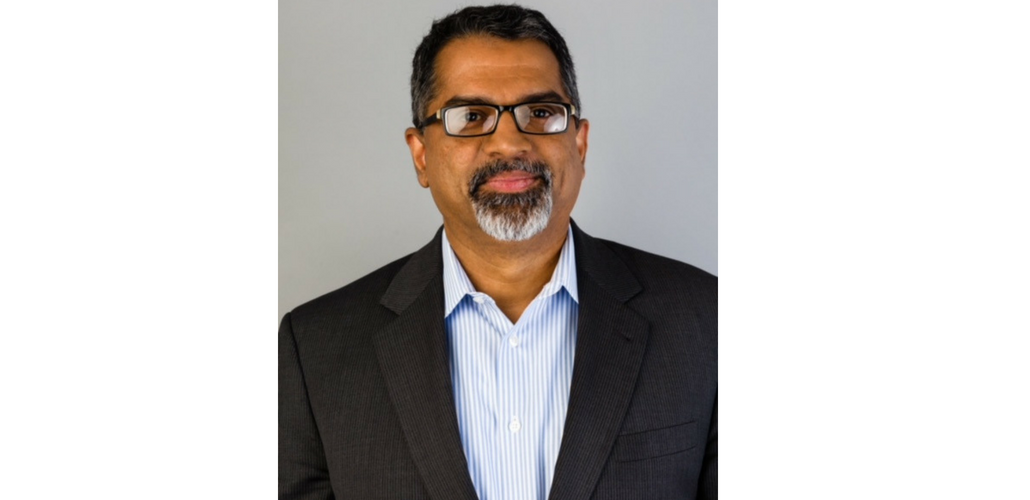 “The faces of African American women were falsely identified more often in the kinds of searches used by police investigators, where an image is compared to thousands or millions of others in hopes of identifying a suspect. . . .”
“The faces of African American women were falsely identified more often in the kinds of searches used by police investigators, where an image is compared to thousands or millions of others in hopes of identifying a suspect. . . .”
Harwell wrote, “The study could fundamentally shake one of American law enforcement’s fastest-growing tools for identifying criminal suspects and witnesses, which privacy advocates have argued is ushering in a dangerous new wave of government surveillance tools.”
But the study also has implications for the news media, according to veteran digital news executive Raju Narisetti (pictured above), professor of professional practice at Columbia Journalism School and director of its Knight-Bagehot Fellowship in Economics and Business Journalism.
“In a way, this broad finding should be intimately familiar to people of color in American newsrooms who know that seeming layer of invisibility and non-recognition when it comes to leadership roles and opportunities over several decades,” Narisetti wrote by email. “Nor is it dissimilar to newsrooms [whose] staffing doesn’t reflect the diverse audiences in their own current and potential audiences.
“Machines learn from humans so the finding that so-called smart systems are prone to the same fallacies, assumptions and errors of our societies when it comes to race and gender should be unsurprising. This finding is also yet another wake-up call, especially for journalists typically prone to automatically give the benefit of doubt to technologies, algorithms and tech-laden institutions, to be far more skeptical and questioning of the outcomes of machine learning, beyond just focusing on the more recently popular privacy concerns.”
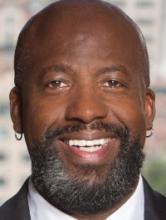 Charlton McIlwain (pictured), professor in New York University’s Department of Media, Culture, and Communication in its Center for Critical Race and Digital Studies, noted that some newsrooms are already using facial technology, at times to the detriment of people of color.
Charlton McIlwain (pictured), professor in New York University’s Department of Media, Culture, and Communication in its Center for Critical Race and Digital Studies, noted that some newsrooms are already using facial technology, at times to the detriment of people of color.
“I do believe we need to be paying more attention to how controversial and socially destructive technologies like facial recognition are being used in journalism,” McIlwain, author of the recent “Black Software:The Internet and Racial Justice: From the AfroNet to Black Lives Matter,” said by email.
“For one reason, news media — print, television, digital — traffic in, and produce troves of images that can be used to feed and train facial recognition systems, which raises questions about the complicity of news outlets in helping to develop these technologies that disproportionately and negatively affect people of color, and African Americans in particular.
“News media — often motivated by the need to ‘understand’ new technologies — also use facial technology in ways that can perpetuate those same biases and compromise personal privacy, as this recent story discussed regarding the NYTimes’s use of facial recognition technology to identify event goers. Again, one of the primary concerns has to do with the ways that such practices mirror what news media and journalists have done for years — to use facial imagery of black and brown people to aid and abet criminal justice enterprises that frequently and disproportionately arrest black and brown ‘suspects’ in error. . . .”
- Ian Bogost, the Atlantic: The Problem With Diversity in Computing (June 25)
- Christopher Intagliata, Scientific American: Artificial Intelligence Learns to Talk Back to Bigots (Oct. 10)
- Journal-isms: A Future Without People of Color in Mind (Feb. 24, 2018)
- Kari Paul, the Guardian: ‘Disastrous’ lack of diversity in AI industry perpetuates bias, study finds (April 16)
- Reveal, Center for Investigative Reporting: Judge backs Reveal’s suit to end secrecy around Silicon Valley’s diversity (Dec. 13)
- S.C. Stuart, PC Magazine: Tech History Is More Than Just ‘White, Male Wizards’ (Oct. 31)
- Christine Schmidt, Nieman Lab: How The Wall Street Journal is building an incubator into its newsroom, with new departments and plenty of hires (Aug. 12)
- Derek Thompson, the Atlantic: Should We Be Afraid of AI in the Criminal-Justice System? (June 20)

Impeachment Covered Through Alternative Facts
“Fox News’ Juan Williams clashed with his co-hosts on The Five today as the impeachment debate in the House continued, saying at one point they’re engaging in ‘Republican blindness,‘ ” Josh Feldman reported Wednesday for Mediaite.
“As Williams and Jesse Watters went back and forth arguing about the polls, Watters said he’s not being honest with their audience about where the numbers are trending. Williams said to the audience, ‘What you hear from my colleagues here is a request for you, the audience, to one, not treat it as a historic thing, even though it’s just the third U.S. President who is going to be impeached. Secondly, ignore it. ‘It’s the Democrats, oh, they’re so wrong… It’s the media!’
“ ‘The Democrats made this history! Donald Trump made a phone call!’ Watters shot back.
“Williams said there’s a ‘clear case of abuse of power,’ but Watters said Trump will win reelection and have a huge mandate when he does.”
 (Pictured: The New York Post, its front page predicting the impeachment vote would backfire on House Speaker Nancy Pelosi, left no doubt about where it stood.)
(Pictured: The New York Post, its front page predicting the impeachment vote would backfire on House Speaker Nancy Pelosi, left no doubt about where it stood.)
Media writer Oliver Darcy of CNN asked Princeton historian and CNN political analyst Julian Zelizer for his perspective on the historic Wednesday, when the House voted for impeachment on a near party-line vote.
Zelizer wrote, in part: “For all the talk on the television panels about this being a historic moment and feeling the weight of this day, partisan positions will only harden and it’s not clear that this will change political feelings in any dramatic way.
“The fault lines that have remained stable throughout this presidency won’t go away. One of the main reasons that this case has to do with a media that will interpret the historical moment through the lens of partisan conflict and to translate the events as just another example of how the parties operate. It’s unclear whether our news media even has the capacity to convey to the public momentous occasions any more or whether the news cycle collapses everything — even something as grandiose as impeachment — into the ongoing saga of partisan conflict that floods our daily news.”
Darcy also wrote, “Tucker Carlson, Sean Hannity, and Laura Ingraham spent Fox’s prime time hours recycling their usual anti-impeachment talking points. Carlson wondered if the Democrats have psychological problems. Hannity said it was part of a ‘disgusting pattern that has gone on for three straight years.’ And Ingraham compared it to a ‘lame circus’ and ‘cheap traveling carnival that never leaves town.’
“Chyrons on the screen matched the hosts’ bombastic and deceptive rhetoric. ‘DELUSIONAL DEMOCRATS WALK OFF IMPEACHMENT CLIFF,’ one read while Hannity ranted. A chyron on Ingraham’s show stated, ‘LEFT’S IMPEACHMENT LIES EXPOSED.’ “
- David Bauder, Associated Press: Ocasio-Cortez Says Fox News Airs ‘Unmitigated Racism’ (Dec. 11)
- Jonathan Capehart, Washington Post: The deplorable hypocrisy of Lindsey Graham and the Republican Party
- Mary C. Curtis, Roll Call: In a fractious holiday season, are there glimmers of hope?
- Elvia Díaz, Arizona Republic: If the outcome is inevitable, should we stop talking about Trump’s impeachment?
- Editorial, Philadelphia Inquirer: For party switch, N.J. Rep. Jeff Van Drew owes voters an apology — and individual donors their money back
- Dan Froomkin, presswatchers.org: The New York Times’s political coverage has completely imploded at the worst possible time
- Dahleen Glanton, Chicago Tribune: Democrats were right to impeach Donald Trump, but polls show the cost could be higher than they anticipated
- Emil Guillermo, Asian American Legal Defense and Education Fund: Trump “Tipped” Over by House as President Is Impeached
- Emil Guillermo, Asian American Legal Defense and Education Fund: America’s Impeachment is our Pro-Democracy Movement (Dec. 10)
- Kamala D. Harris, New York Times: Will McConnell Let the Senate Hold a Fair Impeachment Trial?
- Rod Hicks, the Quill, Society for Professional Journalists: Media essential in impeachment understanding
- Julianne Malveaux, syndicated: Republican Hypocrisy and Double-Talk
- Philip Marcelo, Associated Press: Mayor on Trump’s witch trials remarks: ‘learn some history’
- Lee Moran, HuffPost: Trevor Noah Has A Funny Theory About The GOP’s Bonkers Impeachment Attacks
- Eugene Robinson, Washington Post: Nixon was bad. Trump is much worse.
- Leonard Pitts Jr., Miami Herald: Grow a backbone, Republicans, and a few other parts. Stand up to Trump if you’re so ‘concerned’ (Dec. 3)
- Tracy Wilkinson, Los Angeles Times: Democrats cite civil rights in impeachment fight
- Jim Windolf, New York Times: How TV Covered the Moment of Impeachment
- Bruce C.T. Wright, NewsOne.com: Impeachment Strategies From Democrats And Republicans Show It’s Up To Black Voters To Save The Country, Again (Dec. 9)
‘ Democratic presidential contenders in Thursday’s debate. (Credit: Los Angeles Times)
Democratic presidential contenders in Thursday’s debate. (Credit: Los Angeles Times)
Andrew Yang Sees Media Slight Over His Race
With only seven candidates, the contenders who qualified for the Democratic presidential debate in Los Angeles Thursday each received more time. That was good for Andrew Yang, who had complained that he was being slighted by the media in part because he is Asian American.
“For months, Andrew Yang and his supporters have criticized the news media for not paying more attention to his presidential campaign,“ Kimmy Yam reported Dec. 12 for NBC. “In an interview with NBC News, Yang said he thinks his race may have something to do with it.
“ ‘Race might enter into it in the sense that my candidacy seems very new and different to various media organizations,’ said Yang, who is Asian American. ‘I think you can make an argument that it’s somehow intersecting with some other dynamics.’
“One news organization that has come under particular fire from Yang’s supporters, known as the ‘Yang Gang,’ is MSNBC (which is owned by NBCUniversal, the parent company of NBC News) for having omitted the candidate’s name from polling and fundraising graphics on several occasions, even though Yang has polled better than others in the field who have appeared on screen. CNN has done the same, and Yang has also been misidentified and misnamed several times by other outlets. . . .”
On Dec. 1, Marie Myung-Ok Lee, writer in residence at the Center for the Study of Ethnicity and Race at Columbia University, wrote in the Los Angeles Times that the issue is bigger than Yang.
“Many Asian Americans will relate: White people regularly cut ahead of me in line and then are surprised when I call them out. My Korean American assistant recently reported that a man tried to walk through her on the sidewalk as if she wasn’t there. An invitation on Facebook to talk about such invisibility filled up within minutes, with many Asian Americans saying that being ignored or dismissed happens on a daily basis. . . . “
Three of the four moderators Thursday were women. Like the other women, all from the “PBS NewsHour,” Yamiche Alcindor is African American, while another, Amna Nawaz, is the daughter of Pakistanis. “I think we’re now at the point where when you don’t have a diverse group of moderators, it looks out-of-place,” moderator Judy Woodruff told Stephen Battaglio of the Los Angeles Times.
Woodruff continued, “Because journalists have become more conscious of how important it is to look like the country. We may be late in journalism, but we’ve finally come around. To have a lineup of moderators that is all cookie-cutter, lookalike — that just wouldn’t happen. . . .”
Alcindor asked the candidates their views on violence toward transgender women, many of whom are of color.
- Laura Barrón-López, Politico: Democrats in dissension over all-white 2020 frontrunners
- Rekha Basu, Des Moines Register: Finally, presidential candidates are talking seriously about CAFO [ concentrated animal feeding operations] problems
- Editorial, Boston Globe: Democrats need diversity on the debate stage
- Jon Gabriel, Arizona Republic: Sen. Elizabeth Warren asked black women to hold her accountable, so they did (Dec. 8)
- Katie Halper, Fairness & Accuracy In Reporting: PBS Taps Journalist With Anti-Sanders Bias to Help Moderate Debate
- Farhad Manjoo, New York Times: Pete Ain’t It
- Clarence Page, Chicago Tribune: With Kamala Harris out, many Democrats dread a loss of diversity. But will black voters care? (Dec. 10)
- Trudy Ring, the Advocate: Finally, LGBTQ Issues Get Attention in a Democratic Debate
- Ronell Smith, Dallas Morning News: The failure of the Kamala Harris campaign shows why Democrats have a problem with black voters
- Akemi Tamanaha, AsAmNews: An Asian American Journalist Will Be One of the Moderators of the December Democratic Debate (Dec. 4)
- Veronica Villafañe, Media Moves: Telemundo hires ex NYT journalists to beef up 2020 election digital coverage
- Juan Williams, the Hill: Obama has one more election to win
Blacks Trust Media More Than Latinos, Whites
“Black Americans generally have higher support for and trust in the news media than Hispanic Americans and especially white Americans,” Jeffrey Gottfried, Galen Stocking, Elizabeth Grieco, Mason Walker, Maya Khuzam and Amy Mitchell reported Dec. 12 for the Pew Research Center.
“For example, 57% of blacks say journalists have high or very high ethical standards compared with 49% of Hispanics and 41% of whites. Also, 41% of black adults say news organizations are fair to all sides when covering political and social issues, 10 points higher than Hispanics (31%) and 19 points higher than whites (22%). . . .”
The survey authors also said, “The link between the public’s approval of [President] Trump and views of the news media is clear in evaluations of journalists’ ethics. . . .”
As reported in November, 85 percent of African Americans believed Trump should be impeached, the highest of any ethnic group, according to an NBC News-Wall Street Journal poll. Fifty-seven percent of Hispanics felt the same way, but only 41 percent of whites did.
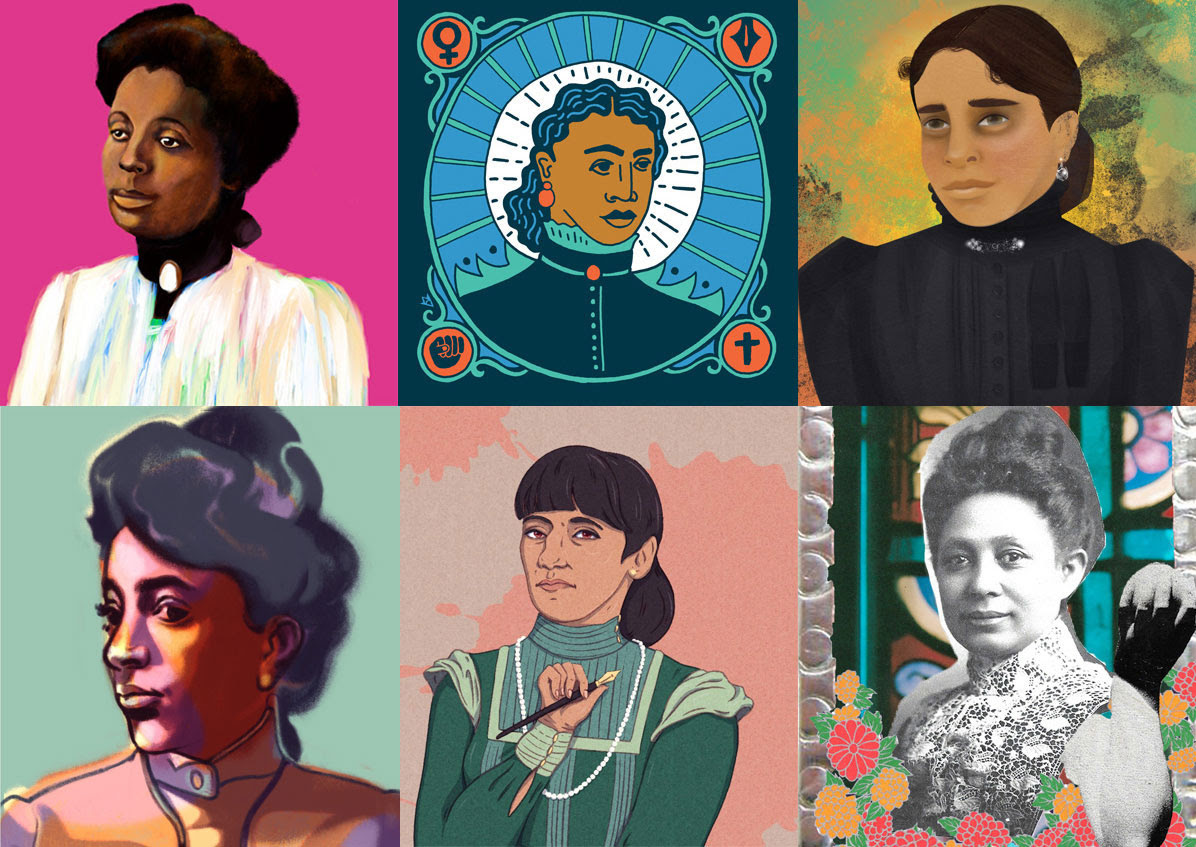 A collage of the art commissioned for the New York Review of Books. Clockwise, from top left, the artists are Johnalynn Holland, Andrea Pippins, Erin Robinson, Elise R. Peterson, Adriana Bellet and Xia Gordon. The subjects are, clockwise from left, Lillian Parker Thomas Fox (1854–1917); Lucy Wilmot Smith (1861–1889); Mary Virginia Cook-Parrish (1862–1945); Victoria Earle Matthews (1861–1907); Dr. Mary Ellen Britton (1855–1925); and Katherine Davis Chapman Tillman (1870–circa 1922).
A collage of the art commissioned for the New York Review of Books. Clockwise, from top left, the artists are Johnalynn Holland, Andrea Pippins, Erin Robinson, Elise R. Peterson, Adriana Bellet and Xia Gordon. The subjects are, clockwise from left, Lillian Parker Thomas Fox (1854–1917); Lucy Wilmot Smith (1861–1889); Mary Virginia Cook-Parrish (1862–1945); Victoria Earle Matthews (1861–1907); Dr. Mary Ellen Britton (1855–1925); and Katherine Davis Chapman Tillman (1870–circa 1922).
Black Female Journalists Were Fierce in 1800s
“How many black women journalists from the nineteenth century can you name? For many, the list starts and ends with Ida B. Wells, the pioneering newspaperwoman and activist whose anti-lynching crusade galvanized a movement,” Maya Millett wrote Nov. 23 for the New York Review of Books. “Wells was celebrated in her own lifetime, and for good reason -— she inspired people on both sides of the Atlantic to pay attention to the atrocities inflicted on black Americans.
“But far from acting alone, she was part of a much larger network of black women journalists who dared to wield their pens in the names of truth and justice. At a time when all women were discouraged from engaging in ‘unladylike’ activities like politics, the women of the black press were boldly writing about racial justice, gender equality, and political reform. . . .
“I started Race Women on Instagram as a way to celebrate pioneering black feminists too often buried by history —- women who, as the name ‘race women’ suggests, devoted their lives to furthering the freedom of the men and women of the race. . . .
“The six journalists profiled here represent just a sample of the constellation of black women in the field who were making significant contributions during this critical time in American history. Gloria Wade-Gayles, a scholar of black women’s history, determined that between 1886 and 1905, nearly fifty black women journalists were reportedly working across the country. . . .”
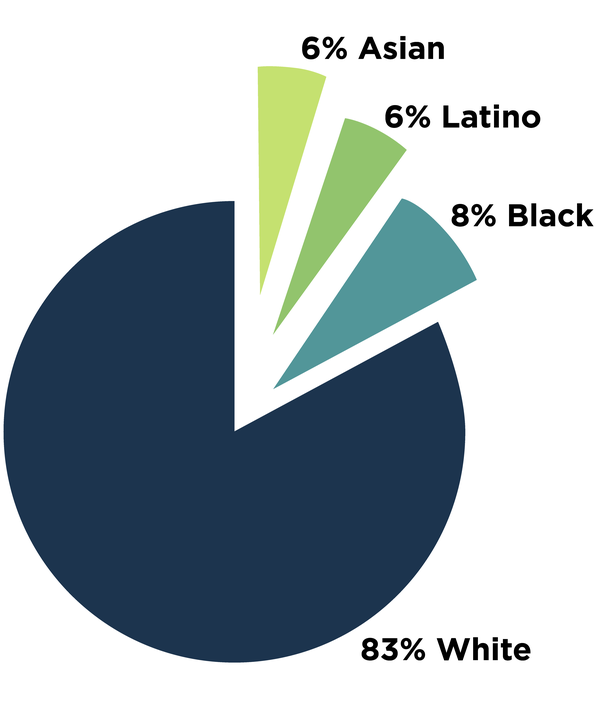 NPR Renews Pledges on Diverse News Sources
NPR Renews Pledges on Diverse News Sources
“Back in FY 2013, white voices made up 80% of sources heard on NPR,” Elizabeth Jensen, NPR’s ombudsman, wrote on Tuesday. “That dropped to 73% in FY 2015, and in FY 2018 jumped back up, to 83%. In the latest tracking, the share of Latino voices remained flat from FY 2015 at 6%, while black voices fell to 8% from 11% and Asian voices fell to 6% from 8%.
“The weekend newsmagazines, particularly Weekend Edition Sunday and Weekend All Things Considered, talked to more racially and ethnically diverse sources than did the weekday newsmagazines.
Jensen also wrote, “The people most often called on to comment fall into categories largely dominated by white men, as well: political or government officials, other journalists, corporate or nonprofit officials or well-known academics and other experts.
“The areas where NPR has the most diverse sources, such as in its education coverage, have the smallest percentage of the overall content. (Arts coverage is an exception; it’s the second-largest slice of the topics pie and also one of the most diverse.) ‘We are doing our best where we are doing our least in content,’ Woods said,” referring to Keith Woods, NPR’s vice president of newsroom training and diversity.
” ‘If we don’t change the proportions and we keep increasing the percentage of stories we’re doing about politics and that chunk of our content either remains the same or grows,’ then the source diversity results are unlikely to fundamentally improve, he said. . . .
“Another of Woods’ takeaways: When stories are primarily about race, ‘there is a far greater percentage of people of color. But most of that increase in people of color is black sources. And when the story is not primarily about race, the percentage of people of color on some shows drops drastically, which means that we are defining diversity of sources as primarily being in stories about race, and not spread more broadly across story topics.”
In an addendum, Jensen wrote, “After we posted this column, we heard back from Cara Tallo, executive producer of All Things Considered, who joined the show in November. She said via email: ‘We are working now with Keith, and a small group of show staff, to create a structure that keeps intentional engagement of diverse sources as a daily priority.
” ‘We are looking to rethink the way we pitch stories, who we have at the table to pitch, and where we look for sources in daily booking. We’re also developing a system to track our progress over time, so that we can hold ourselves accountable going forward.’ “
- Jason Loviglio, Nieman Lab: What do authority and curiosity sound like on the radio? NPR has been expanding that palette from its founding (Dec. 12)
Lincoln Michel Joins Indian Country Today
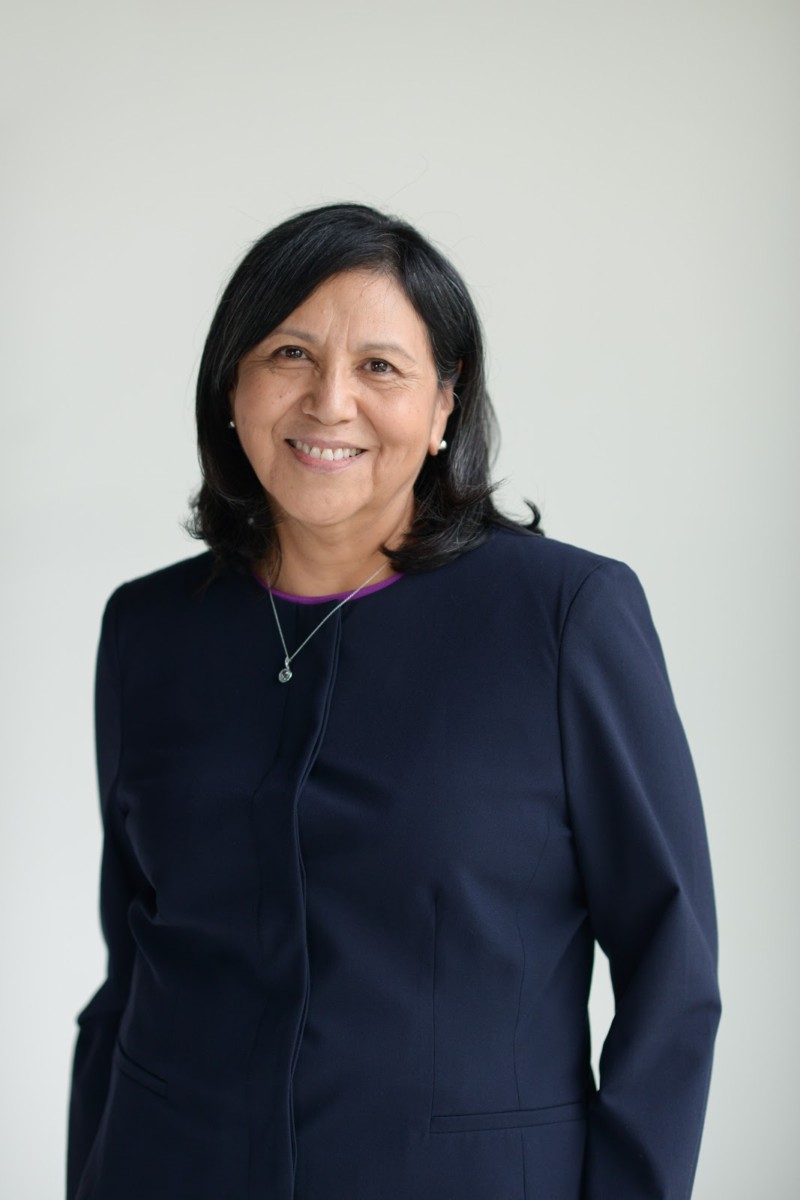 “Indian Country Today will start 2020 with Karen Lincoln Michel (pictured) taking on the role of president of the non-profit company,” the publication announced Tuesday. “Lincoln Michel is Ho-Chunk and is currently the publisher and executive editor of Madison Magazine in Madison, Wisconsin.
“Indian Country Today will start 2020 with Karen Lincoln Michel (pictured) taking on the role of president of the non-profit company,” the publication announced Tuesday. “Lincoln Michel is Ho-Chunk and is currently the publisher and executive editor of Madison Magazine in Madison, Wisconsin.
” ‘I am excited to be part of a news organization that is innovative and is setting a new standard for news coverage of indigenous communities,’ says Lincoln Michel. “Much of my career has been in legacy media, and although I have advocated for fair and accurate coverage of communities of color in each of my roles, I will now have the amazing chance to focus all of my energies on an enterprise that is all about serving Native audiences. . . .’
“ ‘She’ll be in charge of all the business operations,’ says Mark Trahant, editor of Indian Country Today. The company has a 2020 fundraising goal of $2.5 million as it prepares to launch its national newscast. . . .”
Trahant told Journal-isms that Lincoln Michel, like Trahant a former president of the Native American Journalists Association, will be based mostly “in Wisconsin, but she will be in our Phoenix, DC, and Anchorage offices on a regular basis.”

How to Survive Christmas as a Muslim
“Celebrating Christmas wasn’t allowed in my house,” staff writer Aymann Ismail Monday told Slate readers in a piece republished Wednesday in the Dallas Morning News.
“My family is Muslim, the kind that thought saying ‘Merry Christmas’ meant accepting Jesus Christ as your lord and savior. So when we got together as a family during those precious days off from school and work, finding things to do that didn’t involve that fat burglar with the beard was the mission. . . .
“My parents had both immigrated from Egypt in the 1970s, where, I should note, Christmas is very much a thing, except Egyptians celebrate it on Jan. 7, as Eastern Orthodox Christians do, with the big trees and everything.
“But in raising their American kids, they were deathly afraid that they would fail to pass down their own Muslim traditions. They went all out. They enrolled us in an Islamic school where we had days off for the Islamic holidays, too. They enrolled me in Islamic karate classes. And when Christmas time rolled around, they taught me to make the most of my days off by doing absolutely anything except celebrate the reason for them.
“It turned into a kind of game. When we watched TV, we’d strategically change channels to avoid Christmas commercials. When we strung lights in the house, back when Ramadan and Eid were around Christmastime, we avoided the green and red combo. When Christmas carolers would show up to our front door … just kidding, there were never carolers in my tough Newark, N.J., neighborhood. But had there been, we’d have shut off the lights and pretended no one was home.
“As I got older and awakened to the political reality of being a Muslim in America, my refusal to do the Christmas thing became a sort of protest. . . .
“So if you’re like me and spending time with folks who’re more interested in the vacation than the holiday, this Muslim has some tips on how to make the most of it without listening to a single jolly ol’ cheer. . . .”
- Dugan Arnett, Boston Globe: In Boston and beyond, black Santas remain elusive
- Fabiola Santiago, Miami Herald: Those Ganesha shorts are as offensive to Hindus as Che Guevara T-shirts are to Cubans
- Terry Tang, Associated Press: On screen, Asian Americans rarely get into Christmas spirit
He needed them more than me. It’s cold out here,” Tulsa, Okla., photographer Jerome Akintunde said after giving a freed ex-inmate his shoes. (Credit: FTV Live).
Photog Gives Freed Inmate the Shoes on His Feet
‘”KOTV Photographer Jerome Akintunde was doing a live shot outside the Tulsa County Jail with Reporter Reagan Ledbetter,” Scott Jones reported Wednesday for FTV Live.
“We’ll let Ledbetter pick up the story and the selfless act by Akintunde.
“Here is what Ledbetter posted to social media.
“I have a story I want to tell…. He doesn’t know I’m posting this (I’m sure he doesn’t want me to because he doesn’t want the attention) but I am going to brag on my photographer and friend.
“I just witnessed true KINDNESS. This morning at 7:30 my photographer and I finished up our last live shot of the morning (very cold morning) at the Tulsa County Jail. Like any morning we started to put away the lights, the camera and the rest of the gear in the car, so we could hop inside and warm up.
“All of a sudden my photographer started walking towards the entrance of the jail (I thought he was throwing away some trash). After I put the gear in the car I look over and I see him talking to a man in shorts and a t-shirt, with no shoes on…just socks. He just got out of jail minutes earlier. It was 25 degrees outside.
“That’s when all of a sudden I noticed my photographer take his shoes off… then he slid them over to the shivering man. The man put them on. I saw him say ‘thank you’ and my photographer walked back to our car. As he walked up, I looked at him and said ‘did you just give away your shoes?’ … he looks at me and says ‘he needed them more than me. It’s cold out here.’ . . .”
Short Takes
- “”Nieman Fellows in the class of 2020 at Harvard University have selected Puerto Rico’s Centro de Periodismo Investigativo (CPI, the Center for Investigative Journalism) for the 2020 Louis M. Lyons Award for Conscience and Integrity in Journalism,” the Nieman program announced Thursday. “The fellows chose to honor CPI for its relentless drive in investigating the most pressing issues on the island, including the government’s mismanagement of public funds; the death count after Hurricane Maria; the ongoing debt crisis; and the secret communications among the island’s top political leadership in an encrypted messaging app, which when revealed by CPI, sparked protests and ultimately led to Gov. Ricardo Rosselló’s resignation from office. . . .”
- The National Association of Black Journalists and National Association of Hispanic Journalists have added an overflow hotel for their joint Washington convention July 8-12 just days after announcing that the host hotel was taking reservations. “After adding additional rooms, we have now increased our room block to more than 48% higher than what NABJ had in Miami and 71% more than at the joint NABJ-NAHJ convention in 2016 at the Wardman,” NABJ Executive Director Drew Berry wrote Wednesday in a note posted on the NABJ website. “These are signs of growing interest in our organizations. Record hotel reservations and the unprecedented engagement of our partners are very positive signs. . . .”
- A former burial ground thought to contain the remains of slaves has been identified on a Louisiana property where a massive plastic production complex is sited to be built,” Sharon Lerner reported Wednesday for the Intercept. “Human remains along with evidence of grave shafts were identified on land in the St. James Parish where a subsidiary of the Taiwan-based Formosa Plastics Group intends to build 14 facilities to produce plastic bottles, bags, car casings, and synthetic turf, among other products. . . .”
- “This week, in collaboration with The Marshall Project, Race/Related will look at family and incarceration,” Lauretta Charlton, Race/Related editor of the New York Times, wrote subscribers on Tuesday. “Each morning you will receive a special edition of the newsletter focused on the lengths families will go in order to connect with a loved one behind bars. . . .”
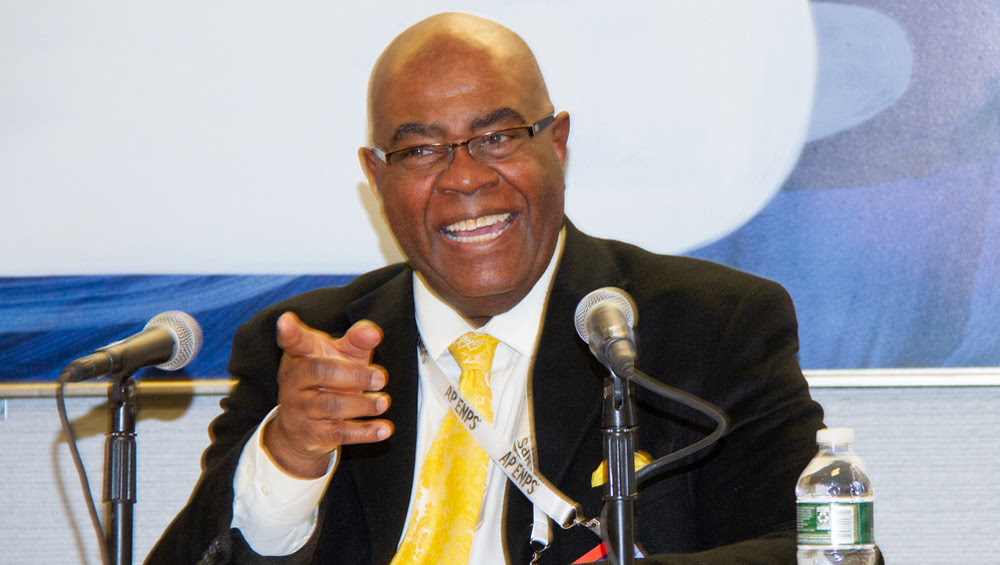 “The Black News Channel, which will launch in at least 33 million cable homes on Jan. 6, 2020, will play its politics right down the middle, promises Gary Wordlaw (pictured), the local TV news veteran who has been tapped to oversee all content for the network as VP of news and programming,” Harry A. Jessell reported Wednesday for TVNewsCheck. Jessell also wrote, “The centerpiece of the network will be a $26 million studio and operations center in Tallahassee, Fla., although the assignment desk will be in Atlanta, the No. 1 African-American TV market. . . . There will be other bureaus in New York, Washington, New Orleans, Chicago and Los Angeles. . . . Another source of news will be the nation’s 223 black-owned newspapers. The network has a deal with every one of them, under which they will supply stories and reporters to appear on air. . . .”
“The Black News Channel, which will launch in at least 33 million cable homes on Jan. 6, 2020, will play its politics right down the middle, promises Gary Wordlaw (pictured), the local TV news veteran who has been tapped to oversee all content for the network as VP of news and programming,” Harry A. Jessell reported Wednesday for TVNewsCheck. Jessell also wrote, “The centerpiece of the network will be a $26 million studio and operations center in Tallahassee, Fla., although the assignment desk will be in Atlanta, the No. 1 African-American TV market. . . . There will be other bureaus in New York, Washington, New Orleans, Chicago and Los Angeles. . . . Another source of news will be the nation’s 223 black-owned newspapers. The network has a deal with every one of them, under which they will supply stories and reporters to appear on air. . . .”
- “Last week, the nonprofit Poynter Institute described several ways independent regional newspapers — including the one you’re reading — have evolved to meet the challenges of the online era,” the Seattle Times editorialized Monday. It concluded, “Citizens and governments at every level should make a mission of aiding this evolution, not abetting the takeover of journalism by venture capitalists. The nation’s free press stands as a core value enshrined in the Constitution. For the sake of communities and democracy, the independent news business must be embraced, preserved and encouraged to succeed.”
- “More than 3,000 journalists lost their jobs this year. These are some of their stories,” read a headline above a story Tuesday by Maya Kosoff on medium.com. She wrote, “While working on this story, I received literally hundreds of messages from people who wanted to speak to me about their experiences getting laid off in 2019, from outlets big and small. . . .”
- “Nexstar Media Group, which bought Tribune Media in September, is shutting down Chicago cable news channel CLTV at the end of the month,” Robert Channick reported Monday for the Chicago Tribune. “The decision, which ends a 26-year run for the pioneering local all-news channel, was announced in an email to staff Monday from Paul Rennie, general manager of WGN-TV and CLTV. . . .”
- “Scientists said on Monday that two patches of land in Tulsa, Okla., could be the sites of mass graves holding victims of a bloody 1921 clash in which white mobs attacked black residents and destroyed a prosperous business district known as Black Wall Street,” Nicholas Bogel-Burroughs reported Tuesday for the New York Times. After airing a story about the development on the “CBS Evening News,” anchor Norah O’Donnell declared, “History everybody needs to know.” The Times story added, “The racist violence nearly a century ago in Tulsa gained new public attention in October when the HBO television series ‘Watchmen’ opened its debut season with a depiction of the massacre. . . .”
- “Indira Lakshmanan (pictured) is joining National Geographic as senior executive editor, overseeing content including coverage of science, environment, history, culture, travel and animals,” the publication announced Tuesday.
 It also said, “Over the course of her distinguished journalism career, Lakshmanan has reported from more than 80 countries on six continents for leading U.S. newspapers, magazines, radio, television, and a wire service, covering everything from wars and world leaders to environmental threats and endangered cultures. . . .”
It also said, “Over the course of her distinguished journalism career, Lakshmanan has reported from more than 80 countries on six continents for leading U.S. newspapers, magazines, radio, television, and a wire service, covering everything from wars and world leaders to environmental threats and endangered cultures. . . .”
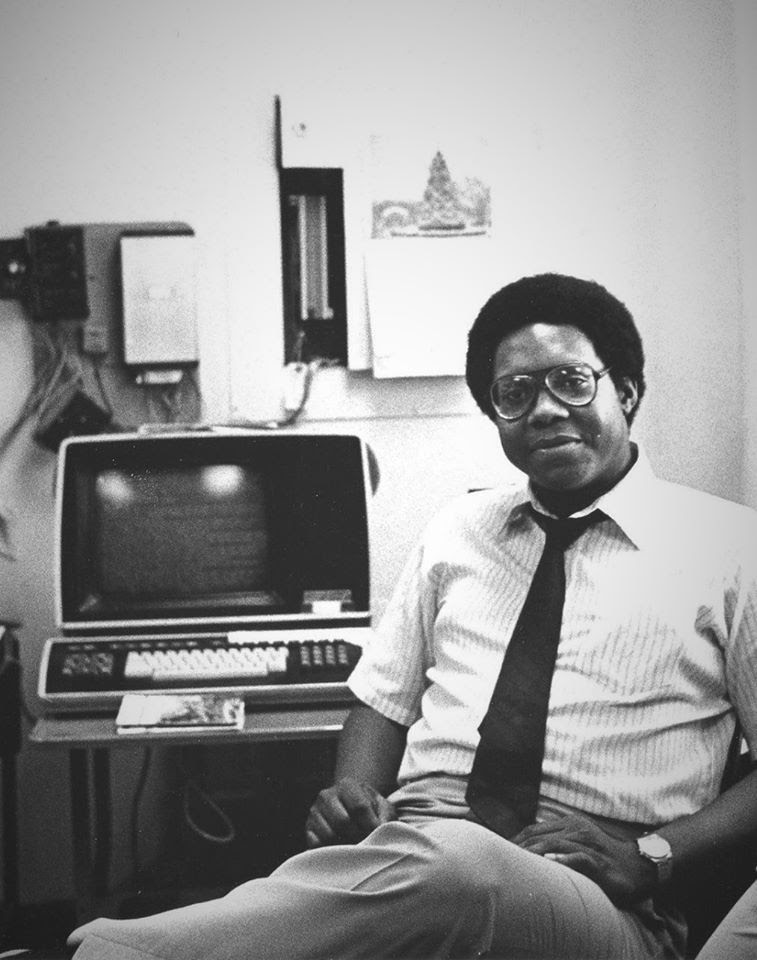 In “two weeks I will be unemployed – voluntarily,” Harold Jackson (pictured), longtime editorial page editor at the Philadelphia Inquirer and currently editorial writer at the Houston Chronicle, told Facebook friends on Monday. “After 44 years as a journalist, I’m retiring. That’s after working for five newspapers, a wire news service, and 11 news media companies (five at one publication; Yo, Philly!) I’ve covered almost every news beat, from G.A. to City Hall. I’ve also done sports, from high school football to NASCAR races. I was in the room when Bear Bryant said he was retiring. I interviewed both George Wallace and Barack Obama. I’ve had some lows (that seven-week Inquirer strike) and some highs (Thank you, Joseph Pulitzer). . . .”
In “two weeks I will be unemployed – voluntarily,” Harold Jackson (pictured), longtime editorial page editor at the Philadelphia Inquirer and currently editorial writer at the Houston Chronicle, told Facebook friends on Monday. “After 44 years as a journalist, I’m retiring. That’s after working for five newspapers, a wire news service, and 11 news media companies (five at one publication; Yo, Philly!) I’ve covered almost every news beat, from G.A. to City Hall. I’ve also done sports, from high school football to NASCAR races. I was in the room when Bear Bryant said he was retiring. I interviewed both George Wallace and Barack Obama. I’ve had some lows (that seven-week Inquirer strike) and some highs (Thank you, Joseph Pulitzer). . . .”
- “NBC News has created a new editorial team to report on issues related to U.S. election security and voting called ‘Vote Watch,’ ” Sarah Fischer reported Thursday for Axios. She also wrote, “The team is led by Janelle Rodriguez, NBC News’ SVP of editorial. . . .”
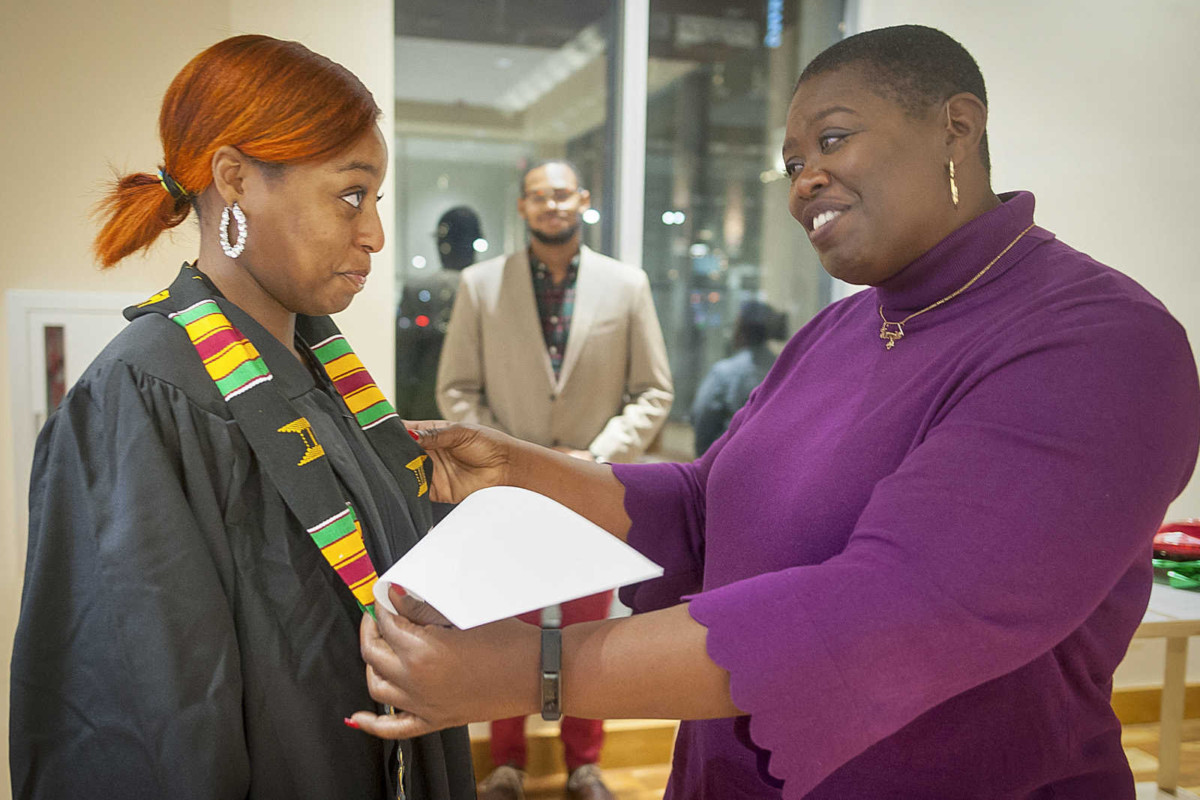 Jasmine Massey, left, is adorned with her Kente stole by adviser Tamara Zellars Buck during the inaugural “Donning of the Kente” ceremony on Dec. 9 at Southeast Missouri State University in Cape Girardeau. The ceremony recognized graduating members of the National Association of Black Journalists. Ben Matthews reported the event for the Southeast Missourian and took this photograph.
Jasmine Massey, left, is adorned with her Kente stole by adviser Tamara Zellars Buck during the inaugural “Donning of the Kente” ceremony on Dec. 9 at Southeast Missouri State University in Cape Girardeau. The ceremony recognized graduating members of the National Association of Black Journalists. Ben Matthews reported the event for the Southeast Missourian and took this photograph.
- Bob Iger, CEO of the Walt Disney Co. and his wife, Willow Bay, dean of the University of Southern California Annenberg School for Communication and Journalism, have committed to a $1 million gift to establish the Iger-Bay Endowed Scholarship at Ithaca College in New York “in support of academic excellence and the institution’s goal of becoming a national model for colleges committed to the values of diversity, equity and inclusion,” the college, Iger’s alma mater, announced Dec. 5.
- “Comcast Corp. executive David L. Cohen, who helped transform the Philadelphia cable company into an international media giant with vast political influence, will step away from his operational roles at the company,” Christian Hetrick and Bob Fernandez reported Dec. 5 for the Philadelphia Inquirer. They also noted, “Even as Cohen led diversity efforts at Comcast, the company came under fire from lawmakers and civil rights groups over a racial-discrimination case now before the U.S. Supreme Court. . . .”
- Soledad O’Brien, journalist, speaker, author and philanthropist, is one of six people appointed to the East Coast Peabody board, Mark K. Miller reported Dec. 11 for TVNewsCheck. “Launched in 2015, the board of directors are separate from the traditional board of jurors that bestow the prestigious Peabody Awards for excellence in broadcasting and digital media. . . .”
- Tracie McKinney “is the new managing editor/assistant news director at WPXI, a position that no other African American woman holds among Pittsburgh’s three local news stations,” Rob Taylor Jr. reported Dec. 10 for the New Pittsburgh Courier.
 “Christine Chambers (pictured), a photographer whose pictures of actors of color helped document the rise of a newly energized black theater movement that began to emerge in New York a decade ago, died on Dec. 4 in Manhattan. She was 39,” Katharine Q. Seelye reported Thursday for the New York Times. Seelye also wrote, “Her work appeared in The New York Times, The Washington Post and The Los Angeles Times, among other publications, as well as in playbills. . . .”
“Christine Chambers (pictured), a photographer whose pictures of actors of color helped document the rise of a newly energized black theater movement that began to emerge in New York a decade ago, died on Dec. 4 in Manhattan. She was 39,” Katharine Q. Seelye reported Thursday for the New York Times. Seelye also wrote, “Her work appeared in The New York Times, The Washington Post and The Los Angeles Times, among other publications, as well as in playbills. . . .”
- “A Japanese civil court awarded about $30,000 in damages to a journalist who alleged she was raped by a powerful television bureau chief, in a case that highlighted Japan’s outdated rape laws and the obstacles women face in alleging sexual misconduct in a nation run by a conservative, male-dominated establishment,” Simon Denyer and Akiko Kashiwagi reported Wednesday for the Washington Post. “Although the compensation was about one-third of what Shiori Ito had sought, the verdict Wednesday marked a victory for women’s rights in Japan and for the country’s nascent #MeToo movement. . . .”
- “The Nigerian government is facing immense criticism over the re-arrest and detention of investigative journalist and activist Omoyele Sowore on treason charges,” Bukola Adebayo reported Dec. 9 for CNN. Adebayo also wrote, “US Sen. Bob Menendez of New Jersey, where Sowore’s family is based, said he was outraged by the ‘blatant harassment’ of the journalist and authorities’ disregard for court orders granting his release on bail. . . .”
- “During Islam’s holy month of Ramadan, Abdul Monem was abducted from the side of the road in northern Libya last June. The 37-year-old Sudanese migrant was then hauled to a warehouse in Bani Walid, a former stronghold of the slain dictator Moammar Gadhafi,” Mat Nashed reported Wednesday for oxy.com. “Crammed into a room with dozens of hostages, Monem’s kidnappers called his friends to extort a $3,000 ransom. They pressed the phone against his ear and began ripping his toenails off with pliers so his friends could hear him scream. Across the globe, images of sinking boats and dead children washing up on shore have epitomized the migrant crisis. But away from that international focus, Bani Walid has emerged as a hub for some of the most horrific abuses that migrants are increasingly facing while passing through Libya. . . .”
Facebook users: “Like” “Richard Prince’s Journal-isms” on Facebook.
Follow Richard Prince on Twitter @princeeditor
Richard Prince’s Journal-isms originates from Washington. It began in print before most of us knew what the internet was, and it would like to be referred to as a “column.” Any views expressed in the column are those of the person or organization quoted and not those of any other entity. Send tips, comments and concerns to Richard Prince at journal-isms-owner@yahoogroups.com
View previous columns (after Feb. 13, 2016).
- Diversity’s Greatest Hits, 2018 (Jan. 4, 2019)
- Book Notes: Is Taking a Knee Really All That? (Dec. 20, 2018)
- Book Notes: Challenging ’45’ and Proudly Telling the Story (Dec. 18, 2018)
- Book Notes: Get Down With the Legends! (Dec. 11, 2018)
- Journalist Richard Prince w/Joe Madison (Sirius XM, April 18, 2018) (podcast)
- Richard Prince (journalist) (Wikipedia entry)
- February 2018 Podcast: Richard “Dick” Prince on the need for newsroom diversity (Gabriel Greschler, Student Press Law Center, Feb. 26, 2018)
- Diversity’s Greatest Hits, 2017 — Where Will They Take Us in the Year Ahead?
- Book Notes: Best Sellers, Uncovered Treasures, Overlooked History (Dec. 19, 2017)
- An advocate for diversity in the media is still pressing for representation, (Courtland Milloy, Washington Post, Nov. 28, 2017)
- Morgan Global Journalism Review: Journal-isms Journeys On (Aug. 31, 2017)
- Diversity’s Greatest Hits, 2016
- Book Notes: 16 Writers Dish About ‘Chelle,’ the First Lady
- Book Notes: From Coretta to Barack, and in Search of the Godfather
- Journal-isms’ Richard Prince Wants Your Ideas (FishbowlDC, Feb. 26, 2016)
- “JOURNAL-ISMS” IS LATEST TO BEAR BRUNT OF INDUSTRY’S ECONOMIC WOES (Feb. 19, 2016)
- Richard Prince with Charlayne Hunter-Gault,“PBS NewsHour,” “What stagnant diversity means for America’s newsrooms” (Dec. 15, 2015)
- Book Notes: Journalists Follow Their Passions
- Book Notes: Journalists Who Rocked Their World
- Book Notes: Hands Up! Read This!
- Book Notes: New Cosby Bio Looks Like a Best-Seller
- Journo-diversity advocate turns attention to Ezra Klein project (Erik Wemple, Washington Post, March 5, 2014)
Columns below from the Maynard Institute are not currently available but are scheduled to be restored soon on journal-isms.com.List
- Book Notes: “Love, Peace and Soul!” And More
- Book Notes: Book Notes: Soothing the Senses, Shocking the Conscience
- Diversity’s Greatest Hits, 2015
- Diversity’s Greatest Hits, 2014
- Diversity’s Greatest Hits, 2013
- Diversity’s Greatest Hits, 2012
- Diversity’s Greatest Hits, 2011
- Diversity’s Greatest Hits, 2010
- Diversity’s Greatest Hits, 2009
- Diversity’s Greatest Hits, 2008
- Book Notes: Books to Ring In the New Year
- Book Notes: In-Your-Face Holiday Reads
- Fishbowl Interview With the Fresh Prince of D.C. (Oct. 26, 2012)
- NABJ to Honor Columnist Richard Prince With Ida B. Wells Award (Oct. 11, 2012)
- So What Do You Do, Richard Prince, Columnist for the Maynard Institute? (Richard Horgan, FishbowlLA, Aug. 22, 2012)
- Book Notes: Who Am I? What’s Race Got to Do With It?: Journalists Explore Identity
- Book Notes: Catching Up With Books for the Fall
- Richard Prince Helps Journalists Set High Bar (Jackie Jones, BlackAmericaWeb.com, 2011)
- Book Notes: 10 Ways to Turn Pages This Summer
- Book Notes: 7 for Serious Spring Reading
- Book Notes: 7 Candidates for the Journalist’s Library
- Book Notes: 9 That Add Heft to the Bookshelf
- Five Minutes With Richard Prince (Newspaper Association of America, 2005)
- ‘Journal-isms’ That Engage and Inform Diverse Audiences (Q&A with Mallary Jean Tenore, Poynter Institute, 2008)


